Neighbouring and related scripts
It is a testament to the versatility of the cuneiform system that it was time and again adapted for languages that are very different in structure from Sumerian, the language for which it was first developed. We will focus on some well-documented cases.
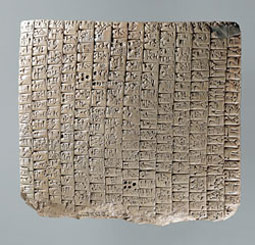
Peace treaty between the cities of Ebla and Abarsal in Eblaite language and cuneiform script (Idlib Museum, inventory no. 1204); second half of third millennium BC. © Metropolitan Museum of Art. View large image on the Ebla Digital Archives (EbDA) website.
Sumerian was the first language to be written in the cuneiform script. It is an agglutinative language; that is, it forms words by adding together units of meaning ("morphemes"). And while there have been many attempts to connect Sumerian to various other agglutinative languages, such as Turkish, Hungarian, Tibetan, Dravidian or the Caucasian languages, it is generally seen as a language isolate with no links to any known language family. This does not mean that it was necessarily isolated also in antiquity, just that it cannot be convincingly linked to any languages which have survived until today or which are documented in writing. There appear to be so many words that are pronounced the same but differ in meaning ("homophones") in Sumerian that it is assumed to be a tonal language, using pitch to distinguish lexical or grammatical meaning (like, for instance, the Chinese languages).
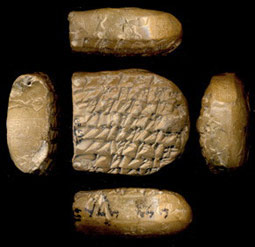
Administrative tablet from Persepolis (OIP 92, 692) in Neo-Elamite cuneiform script with an Aramaic inscription; c. 500 BC. © Oriental Institute, University of Chicago. View large image on the Cuneiform Digital Library Initiative website.
Other languages for which cuneiform was adapted
The first of these languages is, of course, Akkadian, which belongs to the Semitic language family along with Arabic, Aramaic and Hebrew. The key characteristic of Semitic languages is that verbs, nouns and adjectives are formed from 3-consonant roots by adding prefixes, suffixes or infixes, by inserting vowels and/or by doubling individual consonants. Semitic languages are not tonal.
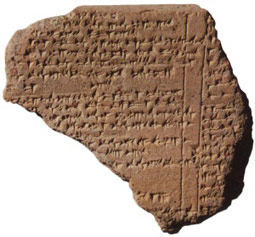
Ritual text in Hittite language and cuneiform script from the city of Sarissa (modern Kusakli) with instructions for an annual festival conducted in spring in honour of the storm god of Sarissa; manuscript from the 13th century BC (KuT 19). © A. Müller-Karpe.
The Akkadian language is recorded in cuneiform script from the mid-third millennium BC onwards. Around the same time, cuneiform was also adapted for another Semitic language, Eblaite – a modern designation after the city of Ebla in northwestern Syria where all known Eblaite texts come from. While Akkadian is attested in the cuneiform script until the beginning of the Common Era, Eblaite cuneiform was used for a much shorter time, for about two centuries. Both these languages were not only recorded syllabically but also made ample use of logograms. Recording Akkadian and Eblaite logographically required knowledge of Sumerian. This is one of the reasons why Sumerian survived as a written language long after it ceased to be spoken, some time in the early second millennium BC.
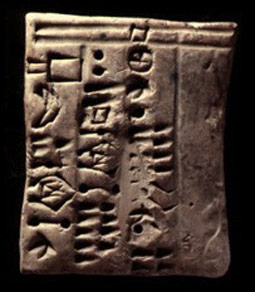
Administrative document from Susa in Proto-Elamite cuneiform script; early 3rd millennium BC. © Metropolitan Museum of Art. View large image on the Cuneiform Digital Library Initiative website.
The cuneiform script as adapted for Akkadian was then also taken over for another language which was not related to Sumerian or to the Semitic languages. Elamite, a language widely used in Southern Iran, was recorded in the cuneiform script for almost as long as Akkadian, from the second half of the second millennium BC until the 4th century BC. Like Akkadian, the script used a mixture of syllabic signs and logograms but it consisted of only about 130 characters at any one time. While initially based on Akkadian signs, over time Elamite cuneiform script underwent its own developments and its signs took their own distinctive shape. Elamite cannot be linked to any of the known language families. It can be read due to its debt to the Akkadian writing system but while most texts are comprehensible, the language itself remains insufficiently understood.
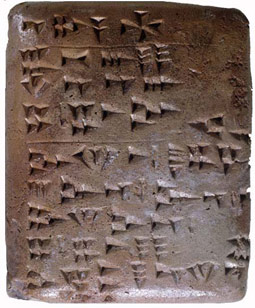
Clay tablet from Ugarit in Ugaritic language and cuneiform script concerning a banqueting society; 13th century BC. © Bruce and Kenneth Zuckerman, West Semitic Research Project (WSRP). View large image on WSRP website.
In the course of the second millennium BC, Akkadian became the language of international diplomacy and was used at royal courts throughout the Middle East, including Egypt and Anatolia, to compose state letters and treaties. This sometimes led to the adaptation of cuneiform to local languages, most prominently Hittite. Hittite belongs to the Indo-European language family (as do most languages currently spoken in Europe, Iran and India). "Hittite" is a modern designation, after the Hittites of the Bible, who are commonly identified with the inhabitants of the kingdom of Hatti with its capital Hattusha (modern Boghazköy). But in antiquity, the language was known as Neshili, "language of (the city of) Nesha", after an important Anatolian centre (modern Kültepe).
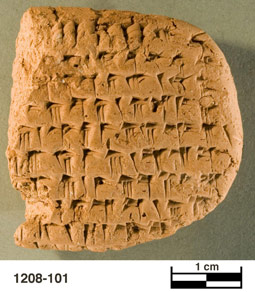
Administrative document from Persepolis (PFT 1208-101) in Old Persian cuneiform script; c. 500 BC. © Oriental Institute, University of Chicago. View large image on the Persepolis Fortification Archive Project website.
Like Akkadian, Hittite was recorded with a mixture of syllabic signs and a sizeable number of logograms, which were derived either from Sumerian or from Akkadian. This already illustrates that the recording of Hittite in the cuneiform script was not meant to be "easy" but required extensive training according to a curriculum that also included the other cuneiform languages. Its use was restricted to the service of the state. At the same time, another, locally developed script was in use that seems to have been more widespread through society, the so-called Luwian hieroglyphs. While cuneiform script did not survive the fall of the Hittite state in the 12th century BC, Luwian hieroglyphic script continued to be used in Anatolia and Northern Syria well into the first millennium BC.
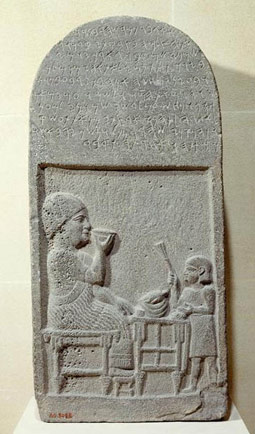
This funerary stele of the priest Si-gabbar from Nerab near Aleppo in Northwestern Syria, today kept in the Louvre (AO3027), bears an alphabetic inscription in Aramaic; 7th century BC. © Louvre Museum. View large image on the Louvre's website.
Other types of cuneiform
Around the turn of the 4th to the 3rd millennium and in the 3rd millennium BC, Sumerian cuneiform and the Sumerian language were also in use in Iran, most importantly in the city of Susa. But for some time the system was replaced by a local variant of writing which, while employing the traditional Mesopotamian writing technology of impressing a stylus into clay, used a completely new repertoire of signs. The language thus recorded is today called Proto-Elamite although it is far too little understood to prove its relationship with Elamite itself. Proto-Elamite is attested only for a relatively short time in the early 3rd millennium and was then replaced again by Mesopotamian cuneiform. But during the period of its use, it is attested over a vast geographical area corresponding to most of modern Iran, stretching from Susa to Tehran and the modern province of Fars.
The Ugaritic language, from the city of Ugarit on the north Syrian coast, was recorded using cuneiform writing technology but with a completely separate sign inventory. Attested from the 14th to the 12th century BC, it is one of the earliest known alphabetic scripts. It uses 31 signs to record consonants and vowels, in the same sequence employed by the other Semitic alphabets attested since the first millennium BC.
Old Persian, too, can be described as a cuneiform script because of the fact that its characters are composed of individual wedge-like strokes. It is clearly inspired by Mesopotamian cuneiform but the writing system uses a completely new repertoire of signs. It comprises three vowels and 22 consonants, some of which also imply the following vowels, thus creating a semi-alphabetic writing system. The script was created in the 6th century BC for the monumental inscriptions of the Achaemenid king Darius I (r. 549-486 BC) and used until the end of the Persian Empire in the 4th century BC. While there is evidence for the use of this script beyond royal monumental inscriptions (in the form of an administrative text from the Persepolis Fortification archive dating to c. 500 BC), the system was only ever employed in state service. Old Persian is directly related to modern Farsi, spoken in Iran today.
Other scripts used in Mesopotamia
Numerous artefacts found in Mesopotamia carry inscriptions in scripts other than cuneiform, such as Egyptian hieroglyphs, the Harappan script from the Indus valley, and Luwian hieroglyphs. But none of these scripts was ever in common use in Mesopotamia itself, although at times scribes who worked in these writing systems enjoyed the patronage of Mesopotamian rulers, such as the Anatolian and Egyptian scholars in the employ of Esarhaddon of Assyria (r. 681-669 BC). The only exception, however, are the different alphabetic scripts which were widely used in Mesopotamia from the early first millennium BC onwards, first in order to record various Semitic languages, most importantly Aramaic, and from the 4th century BC onwards also Greek.
Content last modified on 12 Apr 2024.
Karen Radner
Karen Radner, 'Neighbouring and related scripts', Knowledge and Power, Higher Education Academy, 2024 [http://oracc.museum.upenn.edu/saao/knpp/cuneiformrevealed/aboutcuneiform/neighbouringscripts/]